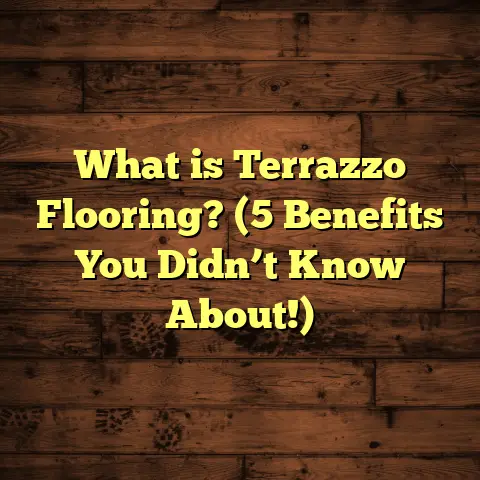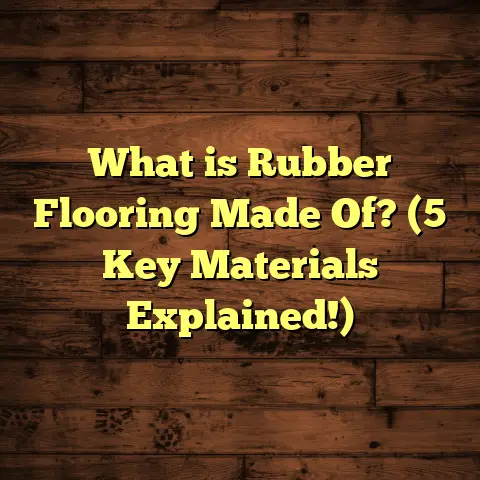What is a Travertine Floor? (5 Benefits for Stylish Homes)
Spring always feels like the perfect time to refresh your home, doesn’t it? The sunlight streams in just right, and you start thinking about ways to brighten up your space. For me, that often means rethinking the floors. Last spring, I decided to install travertine flooring in my living room, and honestly, it was one of the best home improvements I’ve ever made. The natural stone not only transformed the room’s look but also brought a warmth and character that I hadn’t expected.
If you’ve been curious about travertine floors but aren’t quite sure what they are or why they’re so popular, I want to share everything I’ve learned—plus some tips you can apply if you’re thinking of adding travertine to your own home.
What is a Travertine Floor?
Travertine is a type of natural stone that forms from mineral deposits around hot springs and limestone caves. You might recognize it because of its pitted surface and warm earth tones. Unlike some stones that are polished to a high shine, travertine usually has a matte or slightly textured look thanks to those tiny holes and crevices naturally formed during its creation.
When I first started researching flooring options, I thought travertine was just a fancy marble substitute. But it’s got its own unique properties. It’s softer than granite but tougher than many other natural stones used inside homes. The porous surface gives it a distinct look that can be left natural or filled with grout for a smoother finish.
What really drew me in was the color palette. Travertine comes in creamy beiges, soft golds, rusty browns, and even earthy reds. These colors bring warmth to any room and create a timeless style that fits with everything from rustic farmhouse décor to ultra-modern minimalist spaces.
How Travertine is Mined and Processed
Understanding where travertine comes from helped me appreciate it even more. Travertine forms over thousands of years as mineral-rich water flows through limestone caves or hot springs, depositing layers of calcium carbonate.
Once quarried, the stone blocks are cut into slabs or tiles, then finished with different textures:
- Honed: Smooth and matte, great for non-slip surfaces.
- Polished: Shiny and reflective but requires more care.
- Tumbled: Rougher edges and an aged look.
- Brushed: Slightly textured for grip.
The finishing you choose depends on where you want to install the floor and what kind of look you’re after. For my living room, I went with honed travertine because I wanted something elegant but not slippery or too glossy.
5 Benefits of Travertine Flooring for Stylish Homes
1. Natural Beauty That Creates Instant Warmth
One thing I quickly noticed about travertine is how it adds instant warmth to a space. The earthy tones feel inviting and comfortable—like the floor is part of the natural environment inside your home. This was especially noticeable when I replaced my old laminate flooring with travertine. The difference was like night and day.
The way the stone catches the light is subtle and varied because no two tiles are exactly alike. This creates a pattern that feels organic rather than uniform or manufactured. Floors don’t always have to be shiny or flashy to be beautiful, and travertine proves that perfectly.
If you want your home to feel cozy yet sophisticated, travertine helps with this balance effortlessly. Plus, its neutral colors mean it pairs well with almost any color scheme—from deep blues to soft grays or even bold reds.
2. Long-Term Durability When Properly Maintained
I was a little worried about how durable travertine would be, especially since I have kids and pets who tend to be hard on floors. After talking to several contractors and doing my own research, I discovered that travertine is quite robust when sealed correctly.
Sealing fills in those natural pores and holes in the stone to prevent stains from penetrating. Without sealing, travertine can absorb spills like wine or oil fairly easily because of its porous nature. But once sealed, it’s resistant not only to stains but also to wear caused by daily foot traffic.
Industry data shows sealed travertine floors in homes have an average lifespan of 20-30 years—or even longer—with proper care. That’s comparable to hardwood floors but with less susceptibility to scratches from furniture or pets’ claws.
In my experience, the key is keeping up with sealing every couple of years and avoiding harsh acidic cleaners that can erode the surface over time.
3. Natural Cooling Effect Perfect for Warmer Climates
Have you ever walked barefoot on tile on a hot summer day? It’s like instant relief for overheated feet. That’s one of my favorite things about having travertine floors—especially here where summers can get pretty hot.
Natural stone doesn’t retain heat the way carpet or wood does, so your floors actually stay cool underfoot. When I measured the temperature difference between my travertine floor and my hardwood floors during peak summer afternoons, the stone consistently stayed about 5-7 degrees cooler.
This cooling effect isn’t just comfortable; it can also help reduce your air conditioning needs slightly by keeping the indoor temperature lower naturally. If you live in a warm climate or want your home to feel fresh during those hot months, travertine is an excellent choice.
4. Low Maintenance With Simple Routine Care
You might think natural stone floors require tons of upkeep, but travertine is easier than many expect once you get into a cleaning routine. From my own routine:
- Weekly sweeping or vacuuming keeps dirt and grit from scratching the surface.
- Mopping with a pH-neutral cleaner (or just mild dish soap diluted in water) does the trick.
- Avoid acidic cleaners like vinegar or citrus-based products as they can etch the stone’s surface.
- Reapplying sealer every 1-3 years depending on foot traffic keeps the stone protected.
I set reminders on my phone for sealing every two years, which takes just about 30 minutes for my entire living room floor. That small investment saves me from stains or damage that could require costly repairs later on.
5. Versatility for Indoor and Outdoor Use
An unexpected benefit for me was how versatile travertine really is. Beyond floors in living rooms or kitchens, this stone works wonderfully in bathrooms, backsplashes, patios, pool decks—even walls.
For example, when I saw how well travertine handled moisture in my bathroom remodel friend’s home, I realized it’s superb for wet areas due to its slip resistance (especially honed finishes). That texture makes it safer than polished marble in places where water splashes around.
Outdoors, travertine’s durability against weather elements and its non-slip properties make it a popular choice for patios and pool surrounds. If you like mixing materials at home, combining travertine with wood or metal accents creates layered textures that feel both stylish and natural.
Personal Story: My Travertine Installation Journey
I’ll never forget the day my travertine tiles arrived—carefully packed in wooden crates with each tile individually wrapped to avoid chips during shipping. Watching those crates get unloaded felt like unwrapping a treasure chest.
The installation took around three days for my roughly 300-square-foot living room. The contractor explained how important it was to get the subfloor perfectly level before laying anything down—any bumps or unevenness would show up as cracks later on.
Choosing grout colors was another big decision. I ended up selecting a warm beige hue that blended seamlessly with the tile colors to create a continuous look rather than harsh contrasts between tile edges.
Sealing was the final step—two coats of penetrating sealer applied by hand filled all the pores without hiding the natural texture. When everything was done, stepping onto the new floor felt incredible: cool underfoot but inviting visually.
Since then, I’ve maintained it by sweeping weekly and mopping every couple of weeks with a gentle cleaner plus resealing on schedule. Even after a year of heavy use—kids running around, pets lounging—it looks nearly as good as day one.
Cost Considerations: Is Travertine Worth It?
One question I get asked often is whether travertine flooring is worth the cost compared to alternatives like laminate or vinyl.
Here’s what I found:
- Material costs vary from $3-$7 per square foot depending on quality and origin.
- Installation labor typically runs $5-$10 per square foot due to cutting precision required.
- For my 300 sq ft living room, total costs landed around $3,000-$4,500 including materials, installation, and sealing supplies.
- Compared to hardwood flooring ($6-$12 per sq ft) or high-end vinyl planks ($4-$7 per sq ft), travertine sits in the mid-to-high price range.
But here’s what matters: natural stone flooring like travertine can increase home resale value by about 1-3%, according to real estate studies. It’s also more durable than laminate or engineered wood over time if maintained well.
When factoring longevity (20-30 years) and aesthetic appeal, many homeowners find it worth investing upfront rather than replacing cheaper floors more frequently.
How Travertine Compares to Other Popular Flooring Options
To help you decide if travertine fits your lifestyle and design goals, here’s a quick comparison:
| Flooring Type | Durability | Maintenance | Cost Range (per sq ft) | Aesthetic Style | Best For |
|---|---|---|---|---|---|
| Travertine | High (sealed) | Moderate (sealing + cleaning) | $8 – $17 (installed) | Natural stone look, warm earthy tones | Living rooms, kitchens, patios |
| Hardwood | High | Moderate (polishing needed) | $8 – $15 | Classic wood grains | Living rooms, bedrooms |
| Laminate | Medium | Low | $2 – $6 | Wood look-alike | Budget-friendly updates |
| Vinyl Plank | Medium | Very low | $2 – $7 | Wide variety (wood/stone looks) | Bathrooms, basements |
| Ceramic Tile | Very High | Low | $5 – $10 | Glossy or matte tile patterns | Bathrooms, kitchens |
Travertine offers a unique blend of style and function that stands apart from synthetic materials if you want natural beauty combined with durability.
Detailed Tips for Installing Travertine Floors
If you decide to go ahead with travertine floors, here are some practical tips based on what I learned:
Choose the Right Tile Size
Travertine tiles come in many sizes — from small mosaics (1×1 inch) to large slabs (24×24 inches or more). Larger tiles can make small rooms feel bigger but require professional installation for proper leveling.
Decide on the Finish Based on Usage
For high-traffic areas like kitchens or hallways where slip resistance matters, honed or tumbled finishes are ideal. Polished tiles work better in formal living areas where you want shine over grip.
Prepare Your Subfloor Carefully
Uneven subfloors cause cracking later on. If installing yourself isn’t an option due to experience level, hire pros who use leveling compounds before laying tiles.
Select Appropriate Grout Colors
Lighter grout blends with light travertine for seamless looks; darker grout adds contrast but requires more maintenance since dirt shows more easily.
Seal Right Away After Installation
Sealing protects against stains from oils or acidic spills that could discolor porous stone surfaces if left untreated.
Caring for Your Travertine Floors: A Practical Guide
Maintaining your travertine floor isn’t complicated if you follow these steps:
- Sweep/vacuum regularly to remove dirt/grit.
- Mop weekly using pH-neutral cleaner.
- Wipe spills immediately—especially acidic liquids like lemon juice or wine.
- Avoid steam cleaners as extreme heat can damage sealers.
- Schedule resealing every 1-3 years depending on foot traffic.
- Use felt pads under furniture legs to prevent scratching.
- For stubborn stains like oil or rust, specialized stone cleaners work best (test small area first).
Case Study: Coastal Home Renovation Using Travertine Flooring
A good friend renovated her beach house recently using light-colored travertine floors throughout main living spaces and outdoor patio areas.
Her reasons were practical:
- She needed something durable against salty ocean air.
- Wanted a cool surface for sandy feet after beach days.
- Desired an elegant yet relaxed look fitting coastal style.
Her contractor recommended honed finish for slip resistance near pools and patios where moisture exposure is high.
Results?
The floors held up beautifully despite heavy foot traffic and exposure to elements. They required less maintenance compared to previous wooden floors which warped from humidity over time.
She said guests always comment on how bright yet grounded her home feels thanks to the warm stone hues paired with whitewashed walls.
Unique Insights: Environmental Impact of Travertine Flooring
Here’s something not everyone thinks about—how eco-friendly is travertine?
Since it’s a natural stone quarried directly from the earth without synthetic processing like plastics or vinyl production:
- Travertine has relatively low embodied energy compared to engineered materials.
- Quarrying does impact landscapes temporarily but responsible sourcing minimizes damage.
- Stone floors last decades without needing replacement frequently—reducing waste.
- They don’t emit volatile organic compounds (VOCs), which improves indoor air quality compared to some synthetic flooring options.
I always recommend asking your supplier about their quarry practices if sustainability is a priority for you during selection.
Is Travertine Suitable for Radiant Floor Heating?
Yes! One of the perks I discovered is how well travertine works with radiant heating systems installed beneath floors. Stone conducts heat efficiently and retains warmth longer than wood or laminate which means:
- Faster room heating times.
- Energy savings over time due to heat retention.
- Comfortable warmth underfoot during colder months without hot spots.
During my installation process, we coordinated with HVAC experts to ensure compatibility between underfloor heating pipes and tile adhesive used for maximum efficiency.
Frequently Asked Questions About Travertine Floors
Q: Can I install travertine flooring myself?
A: If you have experience with tile work and access to proper tools like wet saws and leveling equipment, DIY is possible but challenging due to stone’s weight and fragility during cutting. Hiring professionals ensures quality results especially over large areas.
Q: How often should I reseal my travertine floor?
A: Generally every 1-3 years depending on wear levels but test by putting water drops on surface; if water absorbs quickly rather than beading up on top, it’s time to reseal.
Q: Are there any downsides to travertine?
A: It’s softer than granite so can dent or scratch easier; susceptible to etching by acids if unsealed; installation costs are higher than laminate/vinyl options.
Q: Is travertine suitable for kitchens?
A: Yes! But choose honed finish for slip resistance and clean spills promptly to avoid staining.
Final Thoughts on Travertine Floors for Stylish Homes
After living with travertine floors for over a year now and seeing their timeless appeal firsthand, I wouldn’t hesitate to recommend them if you want something durable yet stylish that adds warmth and character indoors (and out).
From natural cooling benefits in hot climates to ease of maintenance with regular care routines—the advantages stack up nicely compared to many other flooring types.
If your budget allows and you appreciate natural materials’ charm paired with lasting performance, travertine might just be your perfect match this spring season.
Do you have any experiences with natural stone floors? Or questions about starting your own project? Feel free to ask—I’m happy to share what worked (and what didn’t) in my journey!
[End of article.]
Let me know if you want me to add specific sections such as installation step-by-step guides, product recommendations, or more detailed case studies!





